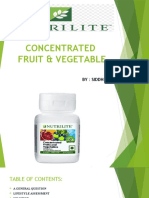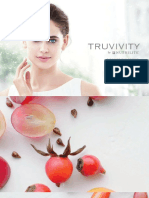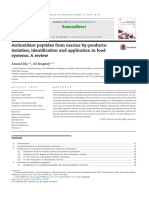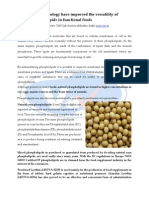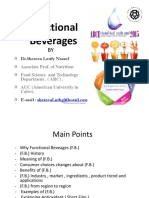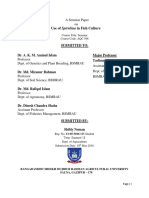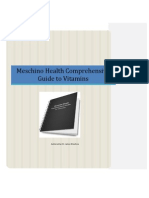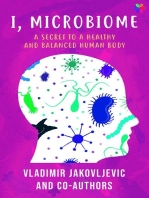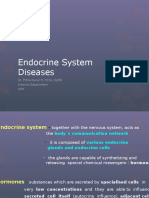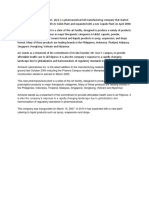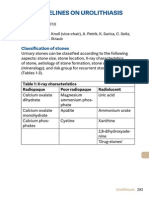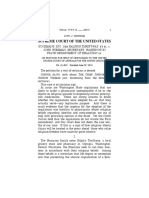Milk Thistle Extract Preparation
Milk Thistle Extract Preparation
Uploaded by
Sinisa KusnjirCopyright:
Available Formats
Milk Thistle Extract Preparation
Milk Thistle Extract Preparation
Uploaded by
Sinisa KusnjirOriginal Description:
Copyright
Available Formats
Share this document
Did you find this document useful?
Is this content inappropriate?
Copyright:
Available Formats
Milk Thistle Extract Preparation
Milk Thistle Extract Preparation
Uploaded by
Sinisa KusnjirCopyright:
Available Formats
GR I1111l l 1IIIIII II Ill1
00,083'7
JHB Inc.
Justin Hill
26216 Alizia Cyn. Dr.
This notification is offered to show exemption from the premarket approval
requirements of the Federal Food and Drug Administration for the use of 2.5ml of the
botanical extract Milk Thistle (Silybum marianum, 2. 5d extract = 50 mg silymarin) as
an ingredient per 355ml serving of a malt based beverage (beer), and prove its status as
Generally Regarded As Safe based on scientific procedures as determined by JHB
InC.
Milk Thistle Extract Preparation
Brucia Plant Extracts, Inc., a leader in quality botanical prepaEitiOnS since 1975,
produce the Milk Thistle extract.
1. All individuals engaged in quality control are conversant with herbal terminology
and have expertise in:
Personnel
2.
1.
1.1 the identification of Milk Thistle
1.2 the recognition of possible adulterants, t e~e~t r i al contaminants, fungal and
insect infestations
1.3 the determination of non-uniformity within the differences in quality between
consignments of plant materials.
Personnel working in storage arms are apprised of, and provided appropriate
training in the handling of raw materials
Specifications for medicinal plant materials include the following:
1.1 botanical identity, including genus, species and authority( e.g., Silybum
1.2 detailed information on
Raw Material Testing
marianum);
1.2.1 geographical source;
1.2.2 cultivation and collection techniques;
1.2.3 time of harvest;
1.2.4 biological age
1.2.5. nature and extent of artificial fertilizers, pesticides, herbicides,
insecticides and fumigants, etc., if used;
1.2.6 nature and extent of radioactive residues, if applicable
- 1 -
1.2.7 where processing cannot be initiated prior to 8 hours after harvesting,
Milk Thistle seeds are stored under conditions that are appropriate for
conservation
Chemistry and Pharmacology
Milk Thistle seeds contain 1.5-3 % flavoneligands, collectively referred to as silymarin
(Bruneton, 1995; Wichtl and Bisset, 1994); 20-30% fixed oil, of which approximately
60% is lenoleic acid, approximately 30% is oleic acid, and approximately 9 % is
palmitic acid; 25-30% protein; 0.038% tocopherol; 0.63% sterols. Including
cholesterol, campesterol, stigmasterol, and sitosterol; and some mucilage (Meyer-
Buchtela, 1999; Wichtl and Bisset, 1994). The three principle components of silymarin
are the flavanoligans silybin, silychristin, and silidianin (Bruneton, 1995; hung and /
Foster, 1996; Wichtl and Bisset, 1994).
Liquid Extract
The Milk Thistle extract is produced using a MaceratiodPercolation process with
certified organic isolated crushed Milk Thistle seed husks (seed freed from pappus),
pure grain alcohol, and purified water in accordance with the Good Manufacturing
Practices of Herbal medicinal products. The finished liquid Milk Thistle extract
consists of approximately 100 mg silymarin (as determined by USP spectrophotometric
assay method) per 5ml of 6 6 % pure grain alcohol.
The liquid extract is stored in sterilized glass containers, in a mol, dark environment
appropriate for conservation.
Use of Liquid Milk Thistle Extract
The finished Milk Thistle extract is used as an ingredient in a traditional style malt
based beverage (2 row malt, nugget hops, munich malt, carmel malt 690). The Milk
Thistle extract is mixed with the brewed beverage in a finishing tank directly prior to
bottling. Each 355ml glass bottle serving will contain approximately 2.5 ml of Milk
Thistle extract (50 mg silymarin). The Milk Thistle Extract is used as a flavor
enhancer, particularly as a bittering agent.
Overview
The milk thistle of commerce is a standardized preparation extracted from the fruits
(seeds) of Silybum marianum (L.) Gaertn., Asteraceae (syn. Carduus marianus L.), a
plant native to the Mediterranean. The leaves have been used since Greco-Roman times
as an herbal remedy for a variety of ailments, particularly liver problems. Eclectic
physicians in the United States in the latter nineteenth and early twentieth centuries
OOQO39
- 2 -
acknowledged the clinical benefits of preparations from the milk thistle seeds
(technically the fruits) for "Congestion of the liver, spleen, and kidneys ...I' (Felter and
Lloyd, 1983). It is widely used in German phytotherapy for "chronic hepatitis of all
types, " and especially for fatty liver (cirrhosis) associated with alcoholics (Weiss,
1988).
Milk thistle is an example of a preparation that is required to be in the standardized,
concentrated form in order to fully convey the desired, in this case, hepatoprotectant,
effects. Milk thistle preparations are usually standardized to a concentration of 70 to
80% of three flavonolignans (silibinin, silychristin, and silydianin), collectively known
as silymarin. According to research conducted by the original manufacturer and
primary researcher of milk thistle extract, Madaus AG of Cologne, Germany, this level
of concentration of silymarin is required to survive degradation by gastric fluids and in
order to enter into the bloodstream via the intestinal wall. Silymarin is poorly absorbed /'
(20-50%) from the gastrointestinal tract; thus, the concentrated extract is recommended
(Foster and Tyler, 1999; Robbers and Tyler, 1999).
The original product in Germany contains 70 mg silymarin. The Commission E
approved uses and the subsequent use of milk thistle standardized extracts in the United
States are based on a significant amount of chemical, pharmacological, and clinical
research. There have been an estimated 120 clinical studies carried out on the
proprietary milk thistle preparation from Madaus, known in Germany as Legalon@. A
comprehensive and detailed review of the pharmacokinetics and clinical pharmacology
of Legalon@ has been published in English by the manufacturer (Anon., 1989).
Clinical studies suggest or confirm the efficacy of milk thistle extract for various
hepatic disorders, including hepatitis A, alcoholic cirrhosis, and exposure to hazardous
chemicals. Another relatively esoteric use is as a preventive and/or antidote to
poisoning by the deathcap mushroom, Amanita phalloides. A preparation of the
silibinin fraction is available in Germany as an intravenous (i.v.) drip for such acute
cases.
A primary use for silymarin is in the treatment of liver damage due to ingestion of
alcohol. An early double-blind study examined 66 patients, most with alcohol-induced
toxic liver disease (Fintelmann and Albert, 1980). The 31 patients who received 420
mg/day of Legalon@ showed a significant influence on serum levels of glutamic-
oxalacetic transaminase (GOT), glutamic-pyruvic transaminase (GPT), and Gamma-GT
over those 35 patients receiving placebo, with levels returning to normal more quickly
in the treated group than placebo. Another double-blind study with 36 patients suffering
from alcohol-induced liver disease found that pathological liver parameters (GOT,
GPT, Gamma-GT, and bilirubin) were significantly reduced in the patients receiving
silymarin (Legalon@) after six months of treatment compared to the placebo group
(Feher et al., 1990). In another study, a randomized, controlled trial was performed to
determine the effect of silymarin in the treatment of patients with alcohol- and non-
alcohol-induced cirrhosis (Ferenci et al., 1989). Of the 170 patients, 87 received 420
mg of silymarin daily, compared with 83 placebo patients. The mean observation
period was 41 months, with 10 dropouts in the placebo group and 14 in the treatment
group. The four-year survival rate was 58+/-9% in the silymarin-treated patients, and
39+/-9% in the placebo group @=0.036). No adverse side effects of drug treatment
were observed.
In another double-blind, controlled study, the effects of silymarin on chemical,
functional, and morphological alterations of the liver were examined (Salmi and Sarna,
1982). The 106 patients with liver disease in the study were selected on the basis of
elevated serum transaminase levels. A total of 97 patients completed the four-week trial
(47 treated and 50 placebo). A dose of 420 mg a day of silymarin produced a
statistically significant greater decrease of GP" and GOT liver enzymes in the treated
group than in the control. Serum total and bilirubin decreased more in the treated than
in the control group, but the differences were not statistically significant.
Some forms of hepatitis have responded to silymarin treatment. A study reported on 67
subjects treated as outpatients for toxic metabolic liver damage, chronic hepatitis, and
bile duct inflammation (Poser, 1971). After three months of treatment (525 mg/day of
silymarin), chronic hepatitis was found to be significantly improved bioptically.
Conditions associated with bile duct inflammation also responded particularly well.
Another double-blind study looked at the effect of silymarin in the treatment of acute
viral hepatitis (Magliulo et al., 1978). A daily dose of 420 mg therapeutically
influenced the increased serum levels of bilirubin, GOT, and GPT characteristically
associated with acute viral hepatitis. After five days of treatment, the laboratory
parameters regressed more in the treated group than for the placebo group. After three
weeks, more patients in the treated group had attained normal values than in the
placebo group. A statistical analysis showed a difference between GOT and bilirubin
values in the silymarin and placebo groups, with a regression of GPT values in favor of
silymarin. A recent case report of chronic infection by hepatitis B virus and hepatitis C
virus demonstrated potential efficacy of treatment with milk thistle (10 g ground-up
seeds in oatmeal with standardized (70%) milk thistle extract capsules three times daily)
in combination with another herb known for its hepatoprotectant activity,
Phyllanthus amarus (200 mg, three times daily) (McPartland, 1996). In a review of
important European clinical studies ranging from 1971 to 1988 (including those
summarized above), the authors found the data suggests the effectiveness of silymarin
not only in toxic and metabolic liver damage, but also in acute and chronic hepatitis
(Hikino and Kiso, 1988). Silymarin's ability to stabilize the cell membrane and
- 4 -
stimulate protein synthesis, while accelerating the process of regeneration in damaged
liver tissue, was found to be important in its therapeutic efficacy.
The hepatoprotectant effect of milk thistle fractions (silymarin) is documented in other
studies: these compounds can produce both a protective and curative effect on liver
damage resulting from the highly toxic compounds phalloidin and alpha-amanitin (from
the deathcap mushroom, A. phalloides). A multicenter trial conducted from 1979 to
1982 involved 220 cases of Amanita poisoning treated in German, Swiss, and Austrian
hospitals (Hruby, 1984). Silibinin (administered i.v.) in supportive treatment was used.
The mortality rate was 12.8%, compared to a mortality rate of 22.4% in a study where
only 16 of the 205 patients were treated with 20 to 50 mg/kg/day of silibinin
(Floersheim et al., 1982). Hruby concluded that the use of silibinin in addition to
current methods of treating Amanita poisoning could lower mortality rates below any
previously achieved.
A literature review noted that Legalon* is the best-documented agent for the treatment
of toxic liver impairment (Morazzani and Bombardelli, 1995). These authors also
reviewed studies which suggest future use in dermatological and cosmetic products,
based on a number of activities including promoting healing at wound sites, improved
burn healing, and counteracting skin degeneration and aging via anti-inflammatory and
free radical scavenging mechanisms. A more recent review concluded that despite some
flaws in methodology of some of the clinical studies, Legalon* has not demonstrated
adverse side effects and it "may be effectiveLin improving the clinical courses of both
acute and chronic viral, drug- and toxin-induced and alcoholic hepatitis" (Flora et al.,
1998).
Because the well-documented antioxidant activity of silymarin has been shown to
prevent lipoperoxidative hepatic damage by xenobiotic compounds (e.g., alcohol and
certain pharmaceutical drugs), researchers attempted to determine whether milk thistle
would be helpful for patients being administered psychotropic drugs. In a double blind,
placebo-controlled study, the efficacy of silymarin was evaluated in-patients receiving
psychotropic drugs as long-term therapy (Palasciano et al., 1994). Sixty women in the
psychiatric ward of an Italian hospital were selected for the trial, all having been treated
with either phenothiazines and/or butyrophenones for at least five years. They were
randomly divided into four groups, with the silymarin patients receiving 800 mg a day
for 90 days. Results showed that 800 mg/day of silymarin may be useful in the
treatment of some instances of lipperoxidative hepatic damage, such as the damage
that may occur during long-term treatment with the psychotropic drugs.
The therapeutic activity of silymarin is based on two sites or mechanisms of action:
- 5 -
(a) It alters the structure of the outer cell membrane of the hepatocytes in such a way as
to prevent penetration of the liver toxin into the interior of the cell. (b) It stimulates the
action of nucleolar polymerase A, resulting in an increase in ribosomal protein
synthesis, and thus stimulates the regenerative ability of the liver and the formation of
new hepatocytes.
Milk thistle extract provides hepatocellular protection by stabilizing hepatic cell
membranes (McPartland, 1996). Other actions include interruption of enterohepatic
recirculation of toxins, stimulation of protein synthesis and regeneration of damaged
hepatocytes, as well as antioxidant activity (McPartland, 1996).
Recent research on silibinin and silichristin to promote faster regeneration of diseased
liver tissue has focused on the ability of silibinin to stimulate the activity of the
DNA-dependent RNA-polymerase I, causing an increase in rRNA synthesis and an
accelerated formation of intact ribosomes. This results in a general increase in the rate
of synthesis of all cellular proteins. In vivo and in vitro molecular modeling
experiments indicate that silibinin may imitate a steroid hormone by binding specifically
to polymerase I, thus stimulating enzyme activity (Sonnenbichler et al., 1998).
None known.
Contraindications
Side Effects
None known.
Formulations: A mild laxative effect has been observed in occasional instances.
Interactions with Other Drugs
None known.
%
- 6 -
000043
Summary
Milk Thistle extract has become increasingly popular in the United States as a dietary
supplement. Based on the existing and increasing number of clinical studies indicating
its safety and suggesting efficacy, JHB Inc. recognizes 2.5 ml of Milk Thistle extract
(50 mg silymarin) per serving as GRAS and complimentary when added to a malt based
beverage. The data and information that are the basis for the GRAS determination are
available for review and copying by the FDA or will be sent to the FDA upon request.
December 14, .2OOO
JHB Inc.
Justin Hill
26216 Alizia Cyn. Dr.
Calabasas, CA, 91302
References
Anon. 1989. Legalon@. Cologne,Germany: Madaus AG. J
Braun, R. et al. 1997.Standardzulassungen f i r Fertigarzneimittel--Text and
Kommentar. Stuttgart: Deutscher Apotheker Verlag.
Brown, D.J. 1996. Herbal Prescriptions for Better Health. Rocklin, CA: Prima
Publishing. 151-158.
Bruneton, J. 1995. Pharmacognosy, Phytochemistry, Medicinal Plants. Paris: Lavoisier
Publishing.
Deutsches Arzneibuch (DAB 1997). 1997. Stuttgart: Deutscher Apotheker Verlag.
Q Feher, J. et al. 1990. Hepatoprotective activity of silymarin therapy in patients
with chronic alcoholic liver disease. Ow Hetil 130:51.
Felter, H.W. and J.U. Lloyd. 1983. King's American Dispensatory, 18th ed.,
3rd rev. Portland, OR: Eclectic Medical Publications [reprint of 1898 original].
Ferenci, P. et al. 1989. Randomized controlled trial of silymarin treatment in
patients with cirrhosis of the liver. J Hepatol9(1):105-113.
Fintelmann, V. and A. Albert. 1980. The therapeutic activity of Legalon@ in toxic
hepatic disorders demonstrated in a double-blind trial. Therapiewoche 30:5589-5594.
Floersheim, G.L., 0. Weber, P. Tschumi, M. Ulbrich. 1982. [Poisoning by the
deathcap fungus (Amanita phalloides): Prognostic factors and therapeutic measures] [In
German].
Schweiz Med Wochenschr 112(34): 1164-1 177.
Flora, K., M. Hahn, H. Rosen, K. Benner. 1998. Milk thistle (Silybum marianum) for
the therapy of liver disease. Am J Gastroenterol93(2):139-143.
db
Foster, S. and V.E. Tyler. 1999. Tyler's Honest Herbal: A Sensible Guide to the
Use of Herbs and Related Remedies, 4* ed. New York Haworth Herbal Press.
The German Homeopathic Pharmacopoeia (GHP). 1993.Translation.of the Deutsches
Hom"opathisches Arzneibuch (HAB l), 5th suppl. 1991 to the 1st ed. 1978.
Stuttgart: Deutscher Apotheker Verlag. 821-827.
Hikino, H. and Y. Kiso. 1988. Natural Products for Liver Disease. In: Wagner,
H., H. Hikino, N.R. Farnsworth. Economic and Medicinal Plant Research, Vol. 2.
New York: Academic Press. 39-72.
Hoffmann, D. 1992. The New Holistic Herbal. Rockport, MA: Element Books
Ltd. 215.
Hruby, C. 1984. Silibinin in the treatment of deathcap fungus poisoning.
Forum 6:23-26.
Leung, A. Y. and. S. Foster. 1996.Encyclopedia of Common Natural
Ingredients Used in Food, Drugs, and Cosmetics, 2nd ed. New York: John
- 8 -
e
Wiley & Sons, Inc. 366-368. Lust, J.B. 1974. The Herb Book. New York: Bantam
Books. 272-273.
Magliulo, E., B. Gagliardi, G.P. Fiori. 1978. [Results of a double blind study on the
effect of silymarin in the treatment of acute viral hepatitis, carried out at
two medical centers] F German]. Med Klin 73(28-29): 1060-1065.
McPartland, J.M. 1996. Viral hepatitis treated with Phyllanthus amar us and milk thistle
(Silybum marianum): a case report. Complementary Medicine International 3(2):40-42.
Meyer-Buchtela, E. 1999.Tee-Rezepturen--Ein Handbuch fiir Apotheker und Arzte.
Stuttgart: Deutscher Apotheker Verlag.
Morazzani, P. and E. Bombardelli. 1995. Silybum marianum (Carduus marianus).
Fitoterapia 66: 3-42.
Palasciano, G. et al. 1994. The effect of Silymarin on plasma levels of Malon-
Dialdehyde in patients receiving long-term treatment with psychotropic drugs. Curr
Therapeut Res 55(5):537-545.
e
Pares, A. et al. 1998. Effects of silymarin in alcoholic patients with cirrhosis of the
liver: results of a controlled, double-blind, randomized and multicenter trial. J Hepatol
28(4):615-621.
Poser, G. 1971. [Experience in the treatment of chronic hepatitis with silymarin] pn
German]. Arzneimforsch 21(8): 1209-1212.
Robbers, J.E. and V.E. Tyler. 1999. Tyler's Herbs of Choice: The Therapeutic Use of
Phytomedicinals.
New York: Haworth Herbal Press.
Salmi, H.A. and S . Sarna. 1982. Effect of silymarin on chemical, functional, and
morphological alterations of the liver. A double-blind controlled study. Sand J
Gastroenterol 17(4):517-521.
Sonnenbichler, J. , I. Sonnenbichler, F. Scalera. 1998. Influence of the Flavonolignan
Silibinin of Milk Thistle on Hepatocytes and Kidney Cells. In: L.D. Lawson and R.
Bauer (eds.) Phytomedicines of Europe: Chemistryand Biological Activity.
Washington,DC: American Chemical Society, 263-277.
-9-
e
United States Pharmacopeia, 24th revmd National Formulary, 19th ed. (USP 24-
NF19). 1999. Rockville, MD:United States Pharmacopeial Convention, Inc. 2481-
2482.
Weiss, R.F. 1988. Herbal Medicine.Beaconsfield, England: BeaconsfieldPublishers.
Wichtl, M. and N.G. Bisset ( 4 s . ) . 1994. Herbal Drugs and Phytopharmaceuticals.
Stuttgart: Medpharm Scientifc Publishers. 121-123.
Additional Resources
Albrecht, M. et al. 1992. Therapy of toxic liver pathologies with Legalon@. 2 Klin
Med 47 : 87-92.
Bindoli, A., L. Cavallini, N. Siliprandi. 1977. Inhibitory action of silymarin of lipid
peroxide formation in the rat liver mitochondria and microsomes. Biochem Pharmacol
26(24):2405-2409.
a
Campos, R., A. Garrido, R. Guerra, A.Valenzuela. 1989. Silybin dihemisuccinate
protects against glutathione depletion and lipid peroxidation induced by acetaminophen
on rat liver. Planta Med 55(5):417-419.
Foster, S. 1995. Milk Thistle Bibliography and Abstracts. Austin, TX: American
Botanical Council.
Hikino, H., Y. Kiso, H. Wagner, M. Fiebig. 1984. Antihepatotoxic actions of
flavonolignans from Silybum marianum fruits. Planta Med 50(3):248-250.
Kiesewetter, E., I. Mo l t e r , H. Thaler. 1977. [Results of two double-blind studies on
the effect of silymarin in chronic hepatitis] F German]. M e r Magen D m 7(5):318-
323.
Krecman, V., N. Skottova, D. Walterova, J. Ulrichova, V. Simanek. 1998. Silymarin
inhibits the development of diet-induced hypercholesterolemia in rats. Planta
Med 64(2): 138-142.
McGuffm, M., C. Hobbs, R. Upton, A. Goldberg. 1997. American Herbal Product .
Association's Botanical Safety Handbook. Boca Raton: CRC Press. Mourelle, M., P.
Muriel, L. Favari, T. Franco. 1989. Prevention of CC14-induced liver cirrhosis by
silymarin. Fundam Clin Pharm3(3): 183-191.
(Jo@wY7
- 10-
e
Plomteux, G. et al. 1977,Hepatoprotector action of silymarin in human acute viral
hepatitis. Int ResCommun Syst 5.
Saba, P. et al. 1976. Effetti terapeutica della silimarina nelle epatopatie croniche indotte
da psicofarmaci. Gaz Med Ital 135236-25 1.
Schulz, V., R. Hiinsel, V.E. Tyler. 1998. Rational Phytotherapy: A Physicians' Guide
to Herbal Medicine. New York: Springer.
Skottova, N. and V. Krecman. 1998.Silymarin as a potential hypocholesterolaemic
drug. Physiol Res47(1): 1-7.
Valenzuela, A., C. Lagos, K. Schmidt, L. Videla. 1985. Silymarin protection against
hepatic lipid peroxidation induced by acute ethanol intoxication in the rat. Biochem
Pharmacol34(12):2209-2212.
Wagner, H. 1981. Natural Products as Medicinal Agents. Stuttgart:Hippokrates.
Wagner, H. et al. 1984. Plant Drug Analysis. Berlin-Heidelberg; New York; Tokyo:
Springer Verlag.
Wang, M. et al. 1996. Hepatoprotective properties of Silybum marianum herbal
preparation on ethanol-induced liver damage. Fitoterapia 67(2): 166-171.
e
Note
This material was adapted from The Complete German Commission E Monographs-
Therapeutic Guide to Herbal Medicines and onhealth with webmd. M. Blumenthal,
W.R. Busse, A. Goldberg, J. Gruenwald, T. Hall, C.W. Riggins, R.S.Rister (eds.) S.
Klein and R.S. Rister (trans.). 1998. J. Hill 2000.
- 11-
You might also like
- Oliver DragojevicDocument63 pagesOliver Dragojevicshepe100% (1)
- Ebook NutriliteDocument15 pagesEbook Nutrilitecreovation100% (1)
- Grades: - 3 Midterms (20%) Held in Lab - Final (15%) - Comprehensive - Labs (25%) - 94% Is An A - Powerpoints Online!Document3 pagesGrades: - 3 Midterms (20%) Held in Lab - Final (15%) - Comprehensive - Labs (25%) - 94% Is An A - Powerpoints Online!Keesha Mae Urgelles TimogNo ratings yet
- Health Benefits of Prebiotics and Probiotics: Specialty "Food "Document18 pagesHealth Benefits of Prebiotics and Probiotics: Specialty "Food "Alexandra Ioan100% (1)
- Use of Spirulina in Poultry FeedsDocument10 pagesUse of Spirulina in Poultry FeedsVijayaraghavan Gonuguntla100% (1)
- 9781905635863Document18 pages9781905635863Peter Osundwa KitekiNo ratings yet
- HND Dental Nurse AssignmentDocument18 pagesHND Dental Nurse Assignmentandreeal8950% (8)
- Sensate FocusDocument13 pagesSensate FocusMari Forgach100% (1)
- Dietary Supplements and Nutraceuticals: Nutritional Requirements and Health BenefitsFrom EverandDietary Supplements and Nutraceuticals: Nutritional Requirements and Health BenefitsNo ratings yet
- Nutrilite Concentrated Fruit and VegetablesDocument18 pagesNutrilite Concentrated Fruit and VegetablesAchyut SadotraNo ratings yet
- Medical Complications of Type 2 DiabetesDocument422 pagesMedical Complications of Type 2 DiabetesMayracpp.16No ratings yet
- Truvivity by NutriliteDocument10 pagesTruvivity by Nutriliteโยอันนา ยุนอา แคทเธอรีน เอี่ยมสุวรรณNo ratings yet
- VitaminsDocument94 pagesVitaminsFerdauza TupasNo ratings yet
- Benefits of ProbioticsDocument2 pagesBenefits of ProbioticsGeo IuliaNo ratings yet
- Journey of Nutrilite FinalDocument13 pagesJourney of Nutrilite Finalnileshsingh25No ratings yet
- Defining High Fiber Ingredient Terminology Chapter 1Document27 pagesDefining High Fiber Ingredient Terminology Chapter 1Horacio Cuevas100% (1)
- Nutritional and Medical Applications of Spirulina MicroalgaeDocument7 pagesNutritional and Medical Applications of Spirulina MicroalgaenaniyagamiNo ratings yet
- J. Paulo Sousa e Silva, Ana Cristina Freitas - Probiotic Bacteria - Fundamentals, Therapy, and Technological Aspects-Pan Stanford Publishing (2014)Document310 pagesJ. Paulo Sousa e Silva, Ana Cristina Freitas - Probiotic Bacteria - Fundamentals, Therapy, and Technological Aspects-Pan Stanford Publishing (2014)Jorge AlbertoNo ratings yet
- Algae A Potent Antioxidant SourceDocument10 pagesAlgae A Potent Antioxidant SourceAyu SyuhadaNo ratings yet
- Preparation of Inulin From Chicory Roots: H LianthuDocument5 pagesPreparation of Inulin From Chicory Roots: H LianthuDaniel Patel100% (1)
- Asthma and Nutrition ModuleDocument38 pagesAsthma and Nutrition ModuleDeepthi RamNo ratings yet
- Aloe VeraDocument22 pagesAloe VeraNazatul Firdaus ZainonNo ratings yet
- Antioxidant Peptides From Marine By-Productssila2015Document17 pagesAntioxidant Peptides From Marine By-Productssila2015Azmier_AdibNo ratings yet
- Why NutriliteDocument1 pageWhy NutriliteAbhishek ChauhanNo ratings yet
- Fatty Acid Profile of Spirulina Platensis Grown in Different Culture ConditionsDocument30 pagesFatty Acid Profile of Spirulina Platensis Grown in Different Culture ConditionsFrankAyranNo ratings yet
- ProbioticsDocument24 pagesProbioticsAubrey StuecklerNo ratings yet
- Royal Jelly: Navigate BookDocument5 pagesRoyal Jelly: Navigate BookChipratt KuyaNo ratings yet
- Powerpoint Presentation - Vitamins and Dietary Supplements-Unit4Document13 pagesPowerpoint Presentation - Vitamins and Dietary Supplements-Unit4api-499139385No ratings yet
- An Introduction To Nutraceuticals and Cosmeceuticals-3rd Prof-1Document22 pagesAn Introduction To Nutraceuticals and Cosmeceuticals-3rd Prof-1Bismah SaeedNo ratings yet
- Akkermansia Muciniphila Is A Promising ProbioticDocument17 pagesAkkermansia Muciniphila Is A Promising ProbioticAntonio Moncayo100% (1)
- Functional FoodDocument14 pagesFunctional FoodSumeyya Binte Bockthier100% (1)
- Phospholipids For A Healthy LifeDocument3 pagesPhospholipids For A Healthy Lifearun_kedia648No ratings yet
- Kongor Et Al. (2016) PDFDocument10 pagesKongor Et Al. (2016) PDFayuNo ratings yet
- Coconut Oil Composition - 2020Document13 pagesCoconut Oil Composition - 2020Ngọc Nguyễn MinhNo ratings yet
- DNA of The Nutrilite BrandDocument72 pagesDNA of The Nutrilite BrandElizabeth GonzálezNo ratings yet
- (Song and Liu) Becoming A Normative Power? China's Mekong Agenda in The Era of Xi JinpingDocument18 pages(Song and Liu) Becoming A Normative Power? China's Mekong Agenda in The Era of Xi JinpingMateus BilharNo ratings yet
- NUTRILITE ProteinPowder en UsDocument5 pagesNUTRILITE ProteinPowder en UsFauzan IbrahimNo ratings yet
- Anti Nutritional FactorsDocument3 pagesAnti Nutritional FactorsGokul DeviNo ratings yet
- Akkermansia Muciniphila, Prebiotics, and ObesityDocument7 pagesAkkermansia Muciniphila, Prebiotics, and ObesitynepretipNo ratings yet
- Shereen-Lotfy Functional Beverages PDFDocument56 pagesShereen-Lotfy Functional Beverages PDFDr Arshad RazaNo ratings yet
- Use of Spirulina in Fish Culture 13-05-3016Document32 pagesUse of Spirulina in Fish Culture 13-05-3016Francky DureNo ratings yet
- Comprehensive Guide To VitaminsDocument91 pagesComprehensive Guide To VitaminsMeschinohealthNo ratings yet
- Constac For Constipation Treatment by Healing Hands HerbsDocument25 pagesConstac For Constipation Treatment by Healing Hands HerbsHealing Hands Clinic Pune100% (1)
- Algalif Natural Astaxanthin Review of Human Clinical Studies 0917 WebDocument27 pagesAlgalif Natural Astaxanthin Review of Human Clinical Studies 0917 WebKorry Meliana PangaribuanNo ratings yet
- Food Presentation Vitamin BDocument43 pagesFood Presentation Vitamin BSehar Butt100% (1)
- WHFoods KaleDocument15 pagesWHFoods Kalep_nandaNo ratings yet
- Benefits of Sun Flower SeedsDocument20 pagesBenefits of Sun Flower SeedsMohd Idris Mohiuddin100% (1)
- COLEUS FROSHKOLIIpdf PDFDocument6 pagesCOLEUS FROSHKOLIIpdf PDFrachelsantoso5259No ratings yet
- Lung MicribiomeDocument10 pagesLung MicribiomeDitia RahimNo ratings yet
- Inulin and Oligofructose What Are They J. Nutr.-1999-NinessDocument5 pagesInulin and Oligofructose What Are They J. Nutr.-1999-NinessArturo SanchezNo ratings yet
- Nutrilite Competitive ComparisonsDocument21 pagesNutrilite Competitive ComparisonsIndu RajaramNo ratings yet
- Ensuring The Quality of Dietary Supplements: USP Global Public Policy PositionDocument6 pagesEnsuring The Quality of Dietary Supplements: USP Global Public Policy PositionmariumNo ratings yet
- How To Lower Diastolic Blood Pressure - Lifestyle Tips and TreatmentsDocument6 pagesHow To Lower Diastolic Blood Pressure - Lifestyle Tips and TreatmentsPero PericNo ratings yet
- I, Microbiome: A Secret to a Healthy and Balanced Human BodyFrom EverandI, Microbiome: A Secret to a Healthy and Balanced Human BodyNo ratings yet
- What Is NutrigenomicsDocument6 pagesWhat Is NutrigenomicsRitu AilaniNo ratings yet
- Postbiotics-Parabiotics The New Horizons in Microbial Biotherapy and Functional FoodsDocument22 pagesPostbiotics-Parabiotics The New Horizons in Microbial Biotherapy and Functional FoodsLevente BalázsNo ratings yet
- Recent Advances in Methylation: A Guide For Selecting Methylation ReagentsDocument63 pagesRecent Advances in Methylation: A Guide For Selecting Methylation ReagentsTuyết MaiNo ratings yet
- Aging, Cysteine, and GlutathioneDocument4 pagesAging, Cysteine, and Glutathioneapi-26034055No ratings yet
- 7 Ways To Be An Awesome Dietetics StudentDocument13 pages7 Ways To Be An Awesome Dietetics StudentDiafnaNo ratings yet
- Nutrients Why - Benefits, Risk & Side Effects Side Effects (Overdose) How-Natural Source/ Supplements DosesDocument7 pagesNutrients Why - Benefits, Risk & Side Effects Side Effects (Overdose) How-Natural Source/ Supplements Dosesjohnsonkk125No ratings yet
- FUNCTIONALFOODSDocument93 pagesFUNCTIONALFOODSNicoleta RotaruNo ratings yet
- Coleus Forskohlii and Its Forskolin A ReviewDocument5 pagesColeus Forskohlii and Its Forskolin A ReviewESSENCE - International Journal for Environmental Rehabilitation and ConservaionNo ratings yet
- Sodium Butyrate in Animal NutritionDocument23 pagesSodium Butyrate in Animal NutritionÖmer AhsanNo ratings yet
- Nutrilite Diet Supplementsin FinalDocument2 pagesNutrilite Diet Supplementsin FinalAnisur RehmanNo ratings yet
- Note - 7 ViolinaDocument1 pageNote - 7 ViolinaSinisa KusnjirNo ratings yet
- Indole 3 Butyric AcidDocument17 pagesIndole 3 Butyric AcidSinisa KusnjirNo ratings yet
- AutoCAD 2010 IntermediateDocument337 pagesAutoCAD 2010 IntermediateSinisa KusnjirNo ratings yet
- Neurotski PoremecajiDocument59 pagesNeurotski PoremecajiSinisa KusnjirNo ratings yet
- Computer Repair With Diagnostic Flowcharts-Morris RosenthalDocument113 pagesComputer Repair With Diagnostic Flowcharts-Morris RosenthalSinisa Kusnjir100% (1)
- Color - Enhancing Foods For Aquarium Fish: Sivaramakris Hnan.T, IvDocument18 pagesColor - Enhancing Foods For Aquarium Fish: Sivaramakris Hnan.T, IvArun SudhagarNo ratings yet
- Group Interventions.20Document8 pagesGroup Interventions.20joeellNo ratings yet
- Oxygen TherapyDocument14 pagesOxygen TherapyEdward Newgate100% (1)
- GAD Treatment OptionsDocument3 pagesGAD Treatment OptionsRosaNo ratings yet
- Endocrine System DiseasesDocument87 pagesEndocrine System DiseasesFahmiArifMuhammadNo ratings yet
- Questionnaire Plumbing ReviewDocument2 pagesQuestionnaire Plumbing ReviewJhonna TrinidadNo ratings yet
- PT Info Lumbar LaminectomyDocument3 pagesPT Info Lumbar Laminectomyteguh duandaNo ratings yet
- LDPDocument46 pagesLDPSoundradevi ArumugamNo ratings yet
- Painless Injection Helfer SkinDocument5 pagesPainless Injection Helfer SkinAtikah AbayNo ratings yet
- Atls SummaryDocument2 pagesAtls SummaryJayesh D. HaribhaiNo ratings yet
- Article ObesityDocument28 pagesArticle Obesityfirdauswakrado893833No ratings yet
- Case Presentation: - Samraj, Catherine - Thakur, Pratibha - Viswanathan, PreethiDocument107 pagesCase Presentation: - Samraj, Catherine - Thakur, Pratibha - Viswanathan, PreethiRahima AliNo ratings yet
- CJC-1295 - Peptide Sciences: Order Peptides OnlineDocument2 pagesCJC-1295 - Peptide Sciences: Order Peptides Onlinebuypeptideshardy04No ratings yet
- AmherstDocument9 pagesAmherstJeanNo ratings yet
- OPTH 118409 Undesirable Systemic Side Effects of Ophthalmic Drops From T 120716Document9 pagesOPTH 118409 Undesirable Systemic Side Effects of Ophthalmic Drops From T 120716Optm Abdul AzizNo ratings yet
- Andre Sadooun - Posicionsmento Tridimensional Do ImplanteDocument11 pagesAndre Sadooun - Posicionsmento Tridimensional Do ImplanteJefferson ThomazNo ratings yet
- PR CA MammaeDocument4 pagesPR CA MammaeZigran Hakim100% (1)
- MastectomyDocument55 pagesMastectomyLakshita Prajapati100% (4)
- 57136Document123 pages57136ahmadpolyNo ratings yet
- Guideline of Urolithiasis PDFDocument34 pagesGuideline of Urolithiasis PDFMelia IndasariNo ratings yet
- MEDINEWS 2 Howrah Orthopaedic Hospita1Document22 pagesMEDINEWS 2 Howrah Orthopaedic Hospita1Dr Subhashish DasNo ratings yet
- Total AnabolismDocument48 pagesTotal AnabolismTswiglyNo ratings yet
- 20-Chapter 23 IndicatorsDocument26 pages20-Chapter 23 IndicatorsAliyah SajaNo ratings yet
- Craniosynostosis : Case Report Review Neurosurgery Department in Dustira Hospital, Cimahi, West JavaDocument20 pagesCraniosynostosis : Case Report Review Neurosurgery Department in Dustira Hospital, Cimahi, West Javaerwin wijatmikoNo ratings yet
- The Pleiadian Light Hannah BeaconsfieldDocument3 pagesThe Pleiadian Light Hannah BeaconsfieldMeaghan Mathews100% (1)
- Storman's Inc. v. Wiesman DissentDocument15 pagesStorman's Inc. v. Wiesman DissentDoug MataconisNo ratings yet
- AntidepressantsDocument31 pagesAntidepressantsIzhaan AkmalNo ratings yet









